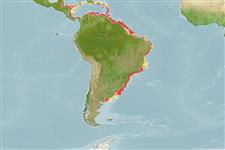Classification / Names
Common names from other countries
Main reference
Size / Weight / Age
Max length : 23.5 cm SL male/unsexed; (Ref. 50628); common length : 20.0 cm TL male/unsexed; (Ref. 5217)
Environment
Marine; freshwater; brackish; pelagic-neritic; anadromous (Ref. 51243); depth range ? - 40 m (Ref. 5217)
Climate / Range
Subtropical, preferred ?; 19°N - 41°S, 88°W - 34°W (Ref. 101638)
Distribution
Western Atlantic: Belize (but no southerly records until Lake Maracaibo, Venezuela); then from Gulf of Venezuela and Trinidad south to Argentina at Carmen de Patagones; also lower and sometimes middle parts of the Orinoco, the Amazon to above Manaus, and Paraná to about Corrientes, and in smaller rivers.
Countries | FAO areas | Ecosystems | Occurrences | Introductions
Short description
Dorsal
spines
(total): 0;
Dorsal
soft rays
(total): 13-14;
Anal
spines: 0;
Anal
soft rays: 21 - 28. Depth widely variable. Snout about 2/3 eye diameter; maxilla moderate, pointed, reaching onto sub-operculum. Gill rakers short, the longest not less than pupil diameter in adults. Dorsal fin origin behind midpoint of body; anal fin origin below 6th-8th branched dorsal fin rays. Silver stripe up to twice eye diameter at widest, lost in fishes over 10 cm SL. Curve of black dots on operculum (Ref. 189). Grayish blue dorsally, fins yellowish with translucent membranes and a blackish caudal margin (Ref. 27363).
IUCN Red List Status (Ref. 115185)
Threat to humans
Harmless
Human uses
Fisheries: minor commercial
More information
ReferencesAquacultureAquaculture profileStrainsGeneticsAllele frequenciesHeritabilityDiseasesProcessingMass conversion
Tools
Special reports
Download XML
Internet sources
Estimates of some properties based on models
Phylogenetic diversity index
PD50 = 0.5312 many relatives (e.g. carps) 0.5 - 2.0 few relatives (e.g. lungfishes)
Trophic Level
3.7 ±0.67 se; Based on food items.
Resilience
Medium, minimum population doubling time 1.4 - 4.4 years (Assuming tmax>3)
Vulnerability
Low to moderate vulnerability (29 of 100)
Price category
